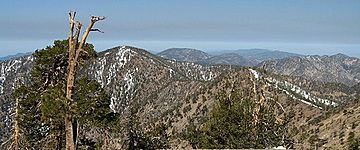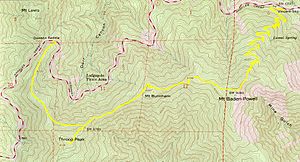Mount Burnham facts for kids
Quick facts for kids Mount Burnham |
|
|---|---|

Summit and ridge
|
|
| Highest point | |
| Elevation | 9,001 ft (2,744 m) NAVD 88 |
| Listing | Hundred Peaks Section |
| Geography | |
| Location | Los Angeles County, California, U.S. |
| Parent range | San Gabriel Mountains |
| Topo map | USGS Crystal Lake |
| Climbing | |
| Easiest route | Hike |
Mount Burnham is a tall peak located in the San Gabriel Mountains in California. It stands proudly within the Sheep Mountain Wilderness, a protected natural area. This mountain is named after Frederick Russell Burnham, a famous American military scout. He taught important outdoor skills, then called woodcraft, to Robert Baden-Powell. This friendship and shared knowledge helped inspire the creation of the Boy Scouts movement.
The USGS officially recognized Mount Burnham in 1951. Before that, it was known by another name: (West Twin) "North Baldy Mountain". The peak is in Los Angeles County, about 16 miles (26 km) north of Glendora. It is also about 66 miles (106 km) from the city of Los Angeles. In 1956, the Sierra Club added Mount Burnham to its list of important "Signature Summits".
Contents
Exploring Mount Burnham
Mount Burnham is a great place for outdoor adventures. Many trails lead to and around the mountain.
Famous Trails
The Silver Moccasin Trail is a long, 53-mile (85 km) path used by Boy Scouts. This trail connects Mount Burnham with other peaks like Mount Baden-Powell, Throop Peak, and Mount Hawkins. The famous Pacific Crest Trail, which stretches across the western United States, follows the same route in this area. These trails offer amazing views and a chance to explore nature.
Plants and Animals of the Mountain
The forests on Mount Burnham are home to many native plants. You can see different types of pine trees here.
Trees and Plants
The peak is covered with several kinds of pine trees. These include the limber pine (Pinus flexilis), lodgepole pine (P. contorta), sugar pine (P. lambertiana), and Jeffrey pine (P. jeffreyi). Other interesting plants you might find are Holodiscus microphyllus, Monardella cinerea, Eriogonum umbellatum, Oreonana vestita, Cycladenia humilis, and the rare yellow-flowered Peirson's lupine (Lupinus peirsonii).
Wildlife
While hiking, you might spot some amazing animals. Bighorn sheep sometimes visit the area. You might even catch a rare glimpse of a mountain lion, though they are very shy.
Mountain Geology
The rocks around Mount Burnham tell a long story about Earth's history.
Rock Formations
The rocks in this area are very old. Some might be from the Pre-Cambrian era, which means they formed billions of years ago. These rocks are likely igneous (formed from cooled lava) or metamorphic (changed by heat and pressure). Other rocks are from the Pre-Cretaceous period. The Vincent Thrust Fault, a very old and important fault line, also runs through this region. It dates back to the Mesozoic Era, the age of dinosaurs.


